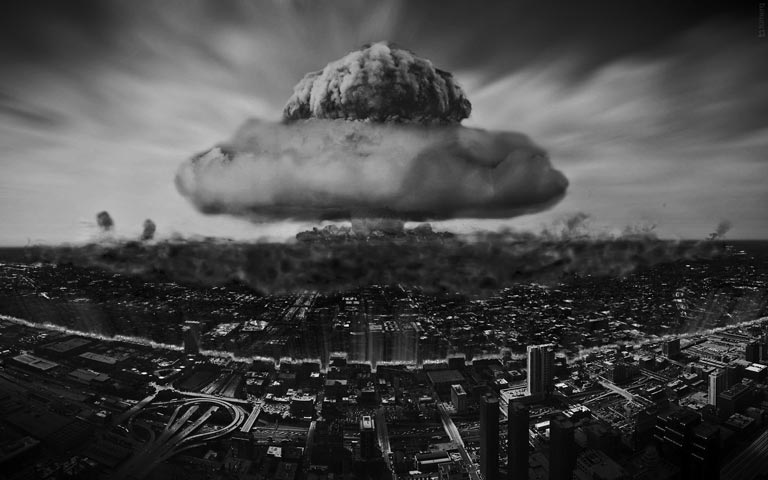Although it is debatable whether or not the seismic readings from 9/11 indicate that explosives were used, it is evident that seismic spikes do not always occur in a demolition.
WHY POPULAR MECHANICS CAN’T FACE UP TO REALITY
Editor’s Note: This is Part 6 (see Part 5) of an extensive report by 9/11 researcher Adam Taylor that exposes the fallacies and flaws in the arguments made by the writers and editors of Popular Mechanics (PM) in the latest edition of “Debunking 9/11 Myths.” We encourage you to submit your own reviews of the book at Amazon.com and other places where it is sold. (Quotes from PM are shown in Bold Light Blue and with page numbers.)
Part 6:
Seismic Spikes
The final section of PM's chapter on the Twin Towers addresses a theory that is not widely believed among members of the 9/11 Truth Movement: that large seismic spikes indicative of explosions occurred before the Towers collapsed. As PM explains:
 Seismographs pick up readings from large events like earthquakes, but according to seismologists, explosions from a controlled demolition would not register.
Seismographs pick up readings from large events like earthquakes, but according to seismologists, explosions from a controlled demolition would not register.
On www.whatreallyhappened.com, the Web site references a graph showing the readings over a 30-minute span. Measured over such a long time period, the collapses do appear as sudden, momentary spikes. But when shown on a more detailed graph covering a 40-second span, it is clear there was sustained seismic activity for the duration of the collapses (pg. 62).
PM's assessment corroborates the findings of the Lamont-Boherty Earth Observatory at Columbia University.1 However, the point that there was not just one sudden seismic spike at Ground Zero has been noted by other supporters of the 9/11 Truth Movement as well.2
In refuting a claim made by very few members of the movement, PM also refutes an argument that several other defenders of the official 9/11 story have made: that any explosives used on 9/11 would have been detected by seismographs. As PM writes (quoting seismologist Arthur Lerner-Lam):
“Demolitions are typically very small explosions,” Lerner-Lam says. “And, you wouldn’t record them anyway because they’d typically be aboveground, and too small to observe” (pg. 63).
This admission in PM's book is noteworthy, as several “debunkers” have in fact argued that the absence of seismic spikes indicates that the Towers were not demolished with explosives.
 The demolition of the Aladdin Hotel in Las Vegas is an example of an explosive event that did not create a seismic signature.
The demolition of the Aladdin Hotel in Las Vegas is an example of an explosive event that did not create a seismic signature.
9/11 researcher Jim Hoffman has confirmed that seismographs do not always record explosions from demolitions:
[This] assertion contrasts with this description of the Aladdin Hotel demolition:
But with the charges positioned aboveground instead of within the earth. . . . the Aladdin implosion didn’t even register on the nearby seismograph at the University of Nevada, Las Vegas, according to geology professor Dave Weide.
Clearly, a demolition’s seismic signature, like its other aspects, is a function of its design. Staggering the detonation of hundreds of charges over time would minimize explosives-induced ground vibrations, which would probably be eclipsed in any case by the relief of strain as tens of thousands of tons of the Towers’ upper sections were severed from their bases, and by the much larger vibrations caused by rubble hitting the ground.3
Although it is debatable whether or not the seismic readings from 9/11 indicate that explosives were used,4 it is evident that seismic spikes do not always occur in a demolition. Therefore, PM's final chapter on the Twin Towers does not contradict the 9/11 Truth Movement’s case for controlled demolition.
PART 7: http://ae911truth.org/adam-taylor/345-news-media-events-debunking-the-real-911-myths-part-07
1 “Seismic Waves Generated by Aircraft Impacts and Building Collapses at World Trade Center, New York City.”; http://www.ldeo.columbia.edu/LCSN/Eq/20010911_WTC/WTC_LDEO_KIM.pdf; by scientists of the Lamont-Doherty Earth Observatory of Columbia University, Palisades, N.Y.
2 See: http://911review.com/errors/wtc/seismic.html
3 Quoted from: http://911research.wtc7.net/reviews/blanchard/index.html
4 This article provides analysis that shows the seismic signals may indicate the use of explosives: http://www.journalof911studies.com/volume/2009/MacQueen_EarlyEarthShake.pdf






